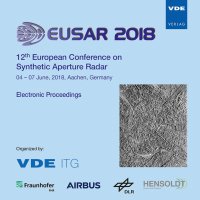Towards the Retrieval of 2-D Vessel Velocities with Single-Platform Spaceborne SAR: Experimental results with the TerraSAR-X 2-looks TOPS Mode
Conference: EUSAR 2018 - 12th European Conference on Synthetic Aperture Radar
06/04/2018 - 06/07/2018 at Aachen, Germany
Proceedings: EUSAR 2018
Pages: 6Language: englishTyp: PDF
Personal VDE Members are entitled to a 10% discount on this title
Authors:
Yague-Martinez, Nestor; Prats-Iraola, Pau; Wollstadt, Steffen; Rodriguez-Cassola, Marc; Sanjuan-Ferrer, Maria J. (Microwaves and Radar Institute, German Aerospace Center (DLR), Weßling, Germany)
Abstract:
The established technique to retrieve velocities of moving targets with Synthetic Aperture Radar (SAR) techniques is Along-track Interferometry (ATI), which provides a measurement of the velocity in the radar line of sight direction. This is achieved by employing two or more phase centers separated in along-track. In case of using a single platform, the line of sight velocity can be retrieved employing a Dual Receive Antenna (DRA) mode. In order to obtain the 2-D velocity of a moving target, the component in the azimuth direction has to be estimated. In this contribution, we propose the use of 2-looks acquisitions for the retrieval of azimuth velocities of vessels employing a single-platform. The 2 looks can be obtained by extracting two sub-bands of the Doppler spectrum of StripMap data. However a smarter solution, which moreover achieves wide coverage (at the expense of resolution), is the use of 2-looks burstmode acquisitions. We introduce the experimental 2-looks Terrain Observation by Progressive Scans (TOPS) mode, presenting the performance that can be achieved with the TerraSAR-X system. We show results with TerraSAR-X DRA StripMap data over coastal areas to demonstrate the retrieval of 2-D velocities of vessels. Experimental TerraSAR-X 2-looks TOPS images are used to demonstrate the retrieval of vessels azimuth velocities with wide coverage. A validation with Automatic Identification System (AIS) data shows that accuracies of 0.85 m/s (1-σ) can be obtained.


